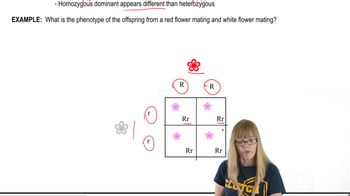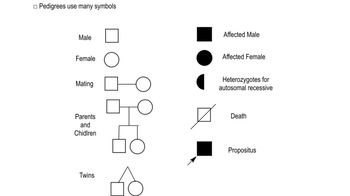Table of contents
- 1. Introduction to Genetics51m
- 2. Mendel's Laws of Inheritance3h 37m
- 3. Extensions to Mendelian Inheritance2h 41m
- 4. Genetic Mapping and Linkage2h 28m
- 5. Genetics of Bacteria and Viruses1h 21m
- 6. Chromosomal Variation1h 48m
- 7. DNA and Chromosome Structure56m
- 8. DNA Replication1h 10m
- 9. Mitosis and Meiosis1h 34m
- 10. Transcription1h 0m
- 11. Translation58m
- 12. Gene Regulation in Prokaryotes1h 19m
- 13. Gene Regulation in Eukaryotes44m
- 14. Genetic Control of Development44m
- 15. Genomes and Genomics1h 50m
- 16. Transposable Elements47m
- 17. Mutation, Repair, and Recombination1h 6m
- 18. Molecular Genetic Tools19m
- 19. Cancer Genetics29m
- 20. Quantitative Genetics1h 26m
- 21. Population Genetics50m
- 22. Evolutionary Genetics29m
2. Mendel's Laws of Inheritance
Pedigrees
Problem 52b
Textbook Question
In humans, the ability to bend the thumb back beyond vertical is called hitchhiker's thumb and is dominant to the inability to do so (OMIM 274200; see Problem 41). Also, the presence of attached earlobes is recessive to unattached earlobes (OMIM 128900).
Check your own phenotype and those of several friends or classmates.
 Verified step by step guidance
Verified step by step guidance1
Identify the phenotypes for hitchhiker's thumb and earlobe attachment in yourself and your friends or classmates.
Determine the genotype for each phenotype. Remember that a dominant phenotype can be either homozygous dominant or heterozygous, while a recessive phenotype must be homozygous recessive.
For hitchhiker's thumb, if a person can bend their thumb back beyond vertical, they have the dominant phenotype. If they cannot, they have the recessive phenotype.
For earlobe attachment, if a person has unattached earlobes, they have the dominant phenotype. If they have attached earlobes, they have the recessive phenotype.
Record the observed phenotypes and infer possible genotypes for each individual based on the dominant and recessive traits.
Recommended similar problem, with video answer:
 Verified Solution
Verified SolutionThis video solution was recommended by our tutors as helpful for the problem above
Video duration:
4mPlay a video:
Was this helpful?
Key Concepts
Here are the essential concepts you must grasp in order to answer the question correctly.
Dominant and Recessive Traits
In genetics, traits can be classified as dominant or recessive based on their expression in an organism. A dominant trait, such as hitchhiker's thumb, will manifest in the phenotype even if only one copy of the allele is present. In contrast, a recessive trait, like attached earlobes, requires two copies of the allele to be expressed. Understanding this distinction is crucial for predicting inheritance patterns.
Recommended video:
Guided course

Variations on Dominance
Phenotype vs. Genotype
The phenotype refers to the observable characteristics or traits of an organism, such as thumb flexibility or earlobe attachment, while the genotype is the genetic makeup that determines these traits. The relationship between genotype and phenotype is essential for understanding how traits are inherited and expressed in individuals. For example, a person with a dominant allele for hitchhiker's thumb will display this trait regardless of their other allele.
Recommended video:
Guided course

Gamete Genotypes
Punnett Squares
Punnett squares are a tool used in genetics to predict the probability of an offspring inheriting particular traits from its parents. By mapping out the possible combinations of alleles from each parent, one can visualize the likelihood of different phenotypes appearing in the offspring. This method is particularly useful for understanding inheritance patterns of traits like hitchhiker's thumb and attached earlobes.
Recommended video:
Guided course

Chi Square Analysis

 2:48m
2:48mWatch next
Master Pedigree Symbols with a bite sized video explanation from Kylia Goodner
Start learning




